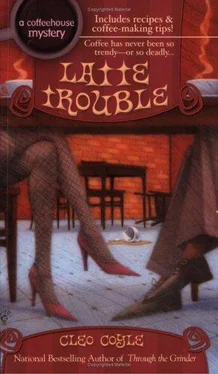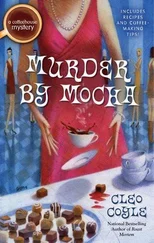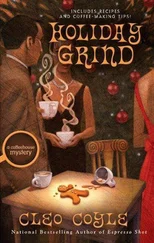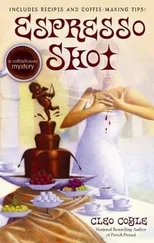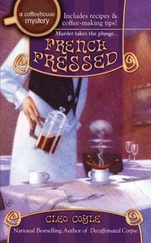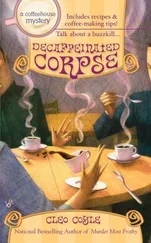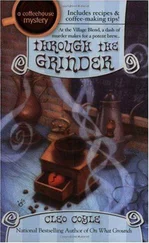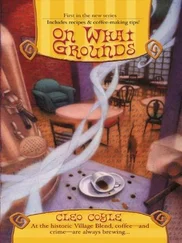Клео Коул - Latte Trouble
Здесь есть возможность читать онлайн «Клео Коул - Latte Trouble» весь текст электронной книги совершенно бесплатно (целиком полную версию без сокращений). В некоторых случаях можно слушать аудио, скачать через торрент в формате fb2 и присутствует краткое содержание. Год выпуска: 2005, ISBN: 2005, Издательство: Berkley, Жанр: Детектив, на английском языке. Описание произведения, (предисловие) а так же отзывы посетителей доступны на портале библиотеки ЛибКат.
- Название:Latte Trouble
- Автор:
- Издательство:Berkley
- Жанр:
- Год:2005
- ISBN:978-0425204450
- Рейтинг книги:3 / 5. Голосов: 1
-
Избранное:Добавить в избранное
- Отзывы:
-
Ваша оценка:
- 60
- 1
- 2
- 3
- 4
- 5
Latte Trouble: краткое содержание, описание и аннотация
Предлагаем к чтению аннотацию, описание, краткое содержание или предисловие (зависит от того, что написал сам автор книги «Latte Trouble»). Если вы не нашли необходимую информацию о книге — напишите в комментариях, мы постараемся отыскать её.
Latte Trouble — читать онлайн бесплатно полную книгу (весь текст) целиком
Ниже представлен текст книги, разбитый по страницам. Система сохранения места последней прочитанной страницы, позволяет с удобством читать онлайн бесплатно книгу «Latte Trouble», без необходимости каждый раз заново искать на чём Вы остановились. Поставьте закладку, и сможете в любой момент перейти на страницу, на которой закончили чтение.
Интервал:
Закладка:
Of course, Madame’s world was not mine. She’d been raised an aristocrat before being forced to flee Europe during the Second World War, finding herself in America with very little to her name. After her first husband—Matteo’s father—died, a life of great wealth followed through her second marriage to the late Pierre. Even though the bulk of his assets had been willed to the children from his first marriage, Madame retained ownership of the fabulous penthouse where she now lived, as well as a modest trust fund for her living expenses.
Coming from solidly working-class roots, I was admitted to Madame’s world through marriage to her son. And through the rocky marriage and divorce, the birth of my daughter Joy, and the move to the New Jersey suburbs and back again, Madame and I had only grown closer. Part of our bond was having more in common than superficially appeared—my own immigrant grandmother had raised me with the same values Madame had come to embrace through the hardships that Nazi-occupied Europe had inflicted on her and her family. The other part was our mutual love of Joy. And, if questioned under torture, I suppose I’d admit that sprinkled in there somewhere was our common affection for Matteo.
When I arrived at the front door, Madame’s personal maid ushered me into the matriarch’s dark, brocaded sitting room, rich with a heady aroma. Coffee had been freshly pressed, and the scent of it nearly knocked me over. I had recently smelled something vaguely similar.
A filigreed tray containing a silver coffee service and petit fours had been laid out on a table of Italian marble, beside an original Tiffany lamp. I no sooner dropped into one of the leather chairs than Madame appeared. Today she was clad in a white silk pantsuit, her silver hair in a French twist, held by an ivory comb.
Madame poured the coffee into delicate china cups. Normally, I would stain the black with a bit of cream, but the scent of this offering was too intriguing. I sipped the rich, hot brew, and looked up, astounded and amazed. I didn’t know exactly what it was—I only knew what it wasn’t.
“This isn’t your usual Jamaica Blue Mountain.”
Madame smiled. “No.” She raised an eyebrow in challenge. “Can you guess?”
For a moment, neither of us spoke as we continued to savor the flavor of this absolutely remarkable coffee, brimming with kaleidoscopic nuances of fruit. The taste was clean and sweet, yet densely rich with hints of blueberry, wine, and spice. It was bright and spirited yet at the same time deeply resonant and balanced. A coffee this complex and alive with fruit almost had to carry a very slight fermented tinge, and it did, but to care would have been like criticizing Da Vinci because he left a stray stroke of paint on the Mona Lisa’s frame.
“Is it Ethiopian?” I asked.
“You’re guessing?”
“To be perfectly honest, the aroma is familiar only because Matt roasted a top secret batch of whatever this is after he came back from Ethiopia, but I’m still not sure what it is. Of course, your son wouldn’t tell me squat.”
“It’s Harrar. Wet-processed.”
“It can’t be.”
“Oh, but it is.”
Grown on small farms in the eastern part of Ethiopia, Harrar was one of the world’s oldest and most traditional coffees. Unlike its more elegant and high-toned wet-processed cousins in other regions of the country—Ghimbi and Yirgacheffe (a.k.a. Sidamo)—Harrar was traditionally a dry-processed coffee, meaning the coffee cherries were picked and put out in the sun to dry, fruit and all, as they had been for centuries.
Such simple dry-processing (or “natural”) methods emphasized bold fruit notes. But the fruit taste could come off as overly wild and fermented. Here, however, the wild fruit character had been tamed. The taste was more balanced, with a longer lasting body than a typical Harrar. And it was far more aromatic. The floral and fruit notes remained intact from the first sip through the last (a real trick in a dark roast). And, as the cup cooled, these flavors assembled themselves differently with each taste. It was a complex and beautifully structured cup, a coffee for those who wished to sip rather than gulp. A coffee worthy of contemplation.
“A coffee like this,” I mused, “used in our espresso blend, would be spectacular.”
“Yes, my dear, just imagine the fine aromatics in the crema.”
I nearly swooned. “More, please.”
As Madame poured, she explained to me that Matteo had personally presented her with five pounds of these beans so that he could explain what he’d secretly been working toward. He and a small Ethiopian farmer he’d befriended had together attempted to experiment with processing methods other than the traditional dry method the farmers of Harrar had used for hundreds of years. No easy feat.
The Ethiopian coffee industry, like many others in the Third World, depends mainly on the work of small-holding farmers with virtually no access to technology and a limited infrastructure. Most Ethiopian farmers still carry their coffee to the mill on their heads. Dry-processing is used in regions where rainfall is scarce and there are long periods of sunshine.
In wet-processing, water is used to remove the four layers surrounding what we know as the “green” coffee bean—the part of the cherry that we roast, then grind and brew. There are other methods, like natural pulping and an experimental process called “repassed” or “raisins,” where the cherries float because they have dried too long on the tree before being collected; then those floaters are removed from the rest and then “repassed” and pulped.
The bottom line, however, is this: while microclimate and soil are contributing factors to the profile of any coffee, processing is usually the single largest contributor to the coffee’s flavor characteristics. The differences between a washed and dry-processed coffee from the same region can be more distinct than two wet-processed coffees from different regions.
Madame spoke up again. “Matt would like to call this the Village Blend Special Reserve.”
I nodded. “And did Matt tell you what his plan was for this Special Reserve?” I asked carefully, thinking this had to be part of Matt’s big kiosk plan: an exclusive coffee for his exclusive settings. Not bad, Matt. Not bad at all.
“Plan?” said Madame, perplexed. “What sort of plan? He plans to sell it at the Blend, of course, what else?”
Again I nodded, this time with nervous indulgence. Obviously, Matt hadn’t told her the rest of his tale—only the “Once Upon a Time” part. I didn’t blame him for breaking the kiosk plan to her slowly, getting her on board with the Special Reserve idea first. Madame had never expressed anything but loathing for the idea of franchising the Village Blend or commercializing its name—the most recent attempt being the rather shady business deal proposed by Eduardo Lebreaux, the Eurotrash importer who had tried to sabotage the landmark coffeehouse after Madame had rejected his offers to purchase it. Madame always believed there should be one Village Blend and only one—or, as she’s been known to say, “There’s only one Eiffel Tower, dear, only one Big Ben, only one Statue of Liberty….”
Although Madame’s employment contracts with Matt and I gave us increasing equity in the business over time, she was presently still the owner. She could shut Matt down with one simple syllable, which was why I wasn’t about to say another thing about it. Frankly, it was up to Matt to inform his mother of his plans, not me.
As our conversation continued, Madame got around to telling me about her date to a major charity function the previous night (lucky her, she was still seeing Dr. McTavish, an oncologist at St. Vincent with the sex appeal of Sean Connery), and I slowly realized Madame wasn’t bringing up the subject of Tucker and the Blend because she hadn’t yet heard about it.
Читать дальшеИнтервал:
Закладка:
Похожие книги на «Latte Trouble»
Представляем Вашему вниманию похожие книги на «Latte Trouble» списком для выбора. Мы отобрали схожую по названию и смыслу литературу в надежде предоставить читателям больше вариантов отыскать новые, интересные, ещё непрочитанные произведения.
Обсуждение, отзывы о книге «Latte Trouble» и просто собственные мнения читателей. Оставьте ваши комментарии, напишите, что Вы думаете о произведении, его смысле или главных героях. Укажите что конкретно понравилось, а что нет, и почему Вы так считаете.
